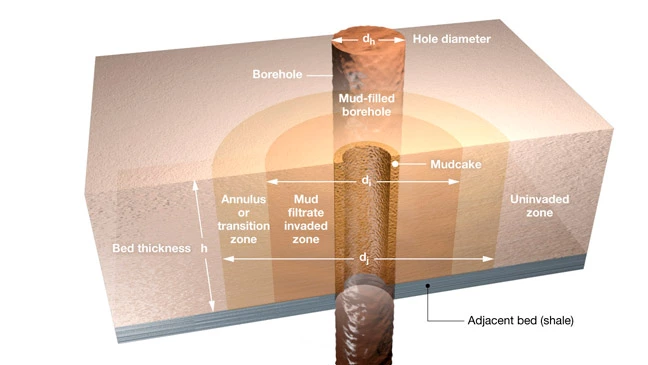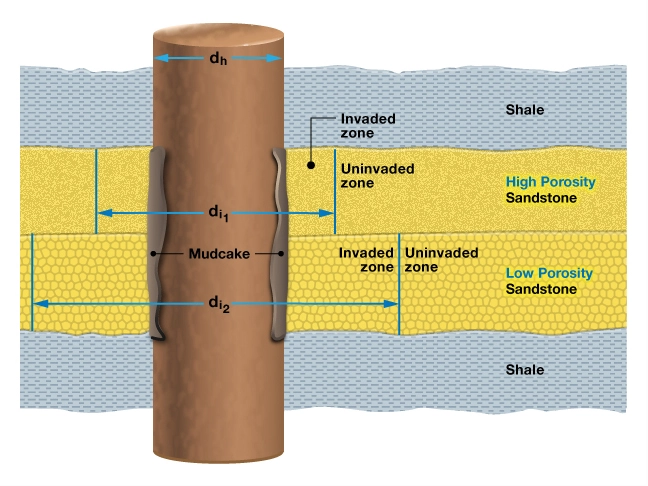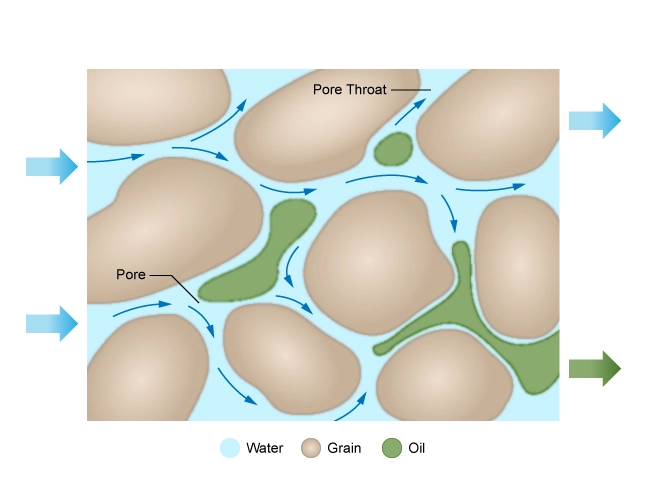Porosity From Resistivity Logs
Resistivity logging tools are primarily used to measure the resistivity of formations at a range of distances away from an open wellbore, and thus establish their water saturations. As a much less important application to hydrocarbon detection, resistivity logs can sometimes be used, in certain specific circumstances, to give approximate estimates of the formation porosity.
Use of Ro and Rw
Archie’s equation (Archie, 1942) for clean formations relates porosity and resistivity to water saturation by the relationship:
![]()
Rearranging this equation, an expression for porosity may be written:

If it is assumed that the formation being evaluated is at 100% water saturation (Sw = 1), then the expression for porosity simplifies to:

Note that Ro has been substituted for Rt because Sw is assumed = 1. Thus, a rough estimate of porosity can be obtained from the formation resistivity, provided the values of all the parameters a, Rw, Ro and m (Figure 1) are known, and the formation is free of any shale and is 100% water saturated. The parameters a and m can only really be obtained by special core analysis (SCAL) studies of full diameter cores. In the absence of core analysis data, the parameter a can be fixed at 1 with an approximation of 2 for the parameter m. However, such an approach would only allow a very rough approximation for the porosity.

Use of Rxo and Rmf
In the flushed zone (Figure 2) which has been invaded by mud filtrate, Archie’s equation for formations without shale content can be written:

Where:
Sxo is the water saturation in the flushed zone.

Rmf can be measured from a sample of mud filtrate pressed from the drilling mud. Rxo data can be acquired by the shallowest reading resistivity logging device run. This could be the shallowest array induction or array laterolog measurement, or a microresistivity tool such as a microspherically focused log or microlaterolog.
An assumption has to be made concerning the value of Sxo. The residual oil saturation (ROS) (Figure 3) in conventional resource reservoirs generally varies between 10% and 30%, with an average value of approximately 20%. Therefore, Sxo can be assumed to be 0.8 +/- in oil reservoirs, but will be closer to 1 in gas reservoirs, which are much more easily flushed by the invading mud filtrate.

Limitations of the Technique
There are considerable limitations to the use and applicability of resistivity logs for porosity estimation. In shaly formations, the porosity estimate will be overly optimistic, increasingly so with increasing shaliness. Relatively few reservoir formations are completely free of shale. In hydrocarbon-bearing zones, the estimated porosity will be pessimistic. Accurate porosity estimates are essential in hydrocarbon-bearing reservoirs in order to establish the hydrocarbon in place (STOIIP and GIIP) estimates.
Porosity determinations from resistivity measurements are, at best, crude approximations. They should only be attempted, as a last resort, in the absence of any other log porosity device such as a sonic log, density log or neutron porosity log. Fortunately, such a scenario very rarely arises.
Significance of Porosity in Well Logging
Porosity is a crucial parameter in well logging due to its significant implications for hydrocarbon exploration and production. Understanding the porosity characteristics of a reservoir allows engineers and geologists to:
- Determine the storage capacity of hydrocarbons within the reservoir.
- Assess the permeability of the formation, which affects fluid flow rates.
- Identify potential zones of interest for drilling and completion activities.
- Optimize production strategies for maximum hydrocarbon recovery.
Conclusion
Porosity is a fundamental parameter in well logging that provides insights into the storage capacity and fluid flow characteristics of a reservoir. Accurate porosity determination is essential for effective reservoir characterization and optimal hydrocarbon exploration and production. By employing various measurement techniques and calculation methods, industry professionals can obtain valuable porosity data for informed decision-making.
 Petro Shine The Place for Oil and Gas Professionals.
Petro Shine The Place for Oil and Gas Professionals.



